Zheng Zhou
Real, Fake, or Manipulated? Detecting Machine-Influenced Text
Sep 18, 2025Abstract:Large Language Model (LLMs) can be used to write or modify documents, presenting a challenge for understanding the intent behind their use. For example, benign uses may involve using LLM on a human-written document to improve its grammar or to translate it into another language. However, a document entirely produced by a LLM may be more likely to be used to spread misinformation than simple translation (\eg, from use by malicious actors or simply by hallucinating). Prior works in Machine Generated Text (MGT) detection mostly focus on simply identifying whether a document was human or machine written, ignoring these fine-grained uses. In this paper, we introduce a HiErarchical, length-RObust machine-influenced text detector (HERO), which learns to separate text samples of varying lengths from four primary types: human-written, machine-generated, machine-polished, and machine-translated. HERO accomplishes this by combining predictions from length-specialist models that have been trained with Subcategory Guidance. Specifically, for categories that are easily confused (\eg, different source languages), our Subcategory Guidance module encourages separation of the fine-grained categories, boosting performance. Extensive experiments across five LLMs and six domains demonstrate the benefits of our HERO, outperforming the state-of-the-art by 2.5-3 mAP on average.
DiffHash: Text-Guided Targeted Attack via Diffusion Models against Deep Hashing Image Retrieval
Sep 16, 2025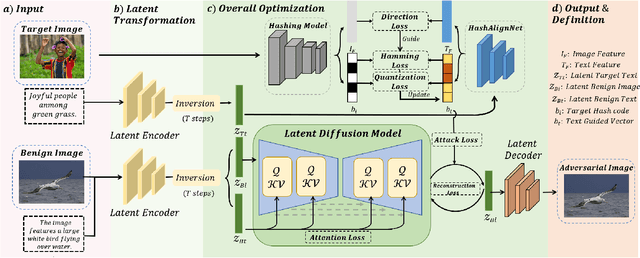

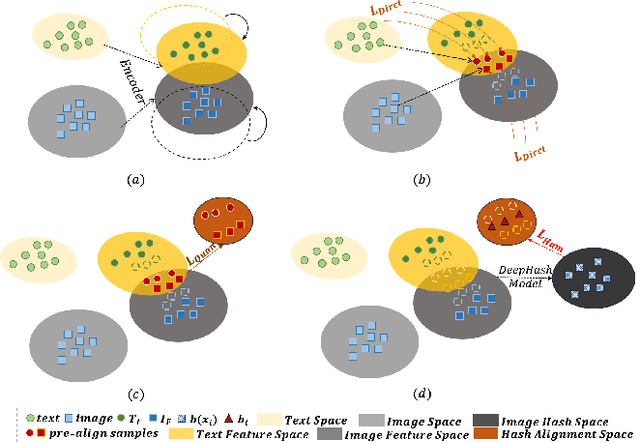

Abstract:Deep hashing models have been widely adopted to tackle the challenges of large-scale image retrieval. However, these approaches face serious security risks due to their vulnerability to adversarial examples. Despite the increasing exploration of targeted attacks on deep hashing models, existing approaches still suffer from a lack of multimodal guidance, reliance on labeling information and dependence on pixel-level operations for attacks. To address these limitations, we proposed DiffHash, a novel diffusion-based targeted attack for deep hashing. Unlike traditional pixel-based attacks that directly modify specific pixels and lack multimodal guidance, our approach focuses on optimizing the latent representations of images, guided by text information generated by a Large Language Model (LLM) for the target image. Furthermore, we designed a multi-space hash alignment network to align the high-dimension image space and text space to the low-dimension binary hash space. During reconstruction, we also incorporated text-guided attention mechanisms to refine adversarial examples, ensuring them aligned with the target semantics while maintaining visual plausibility. Extensive experiments have demonstrated that our method outperforms state-of-the-art (SOTA) targeted attack methods, achieving better black-box transferability and offering more excellent stability across datasets.
Wavelet Mixture of Experts for Time Series Forecasting
Aug 12, 2025Abstract:The field of time series forecasting is rapidly advancing, with recent large-scale Transformers and lightweight Multilayer Perceptron (MLP) models showing strong predictive performance. However, conventional Transformer models are often hindered by their large number of parameters and their limited ability to capture non-stationary features in data through smoothing. Similarly, MLP models struggle to manage multi-channel dependencies effectively. To address these limitations, we propose a novel, lightweight time series prediction model, WaveTS-B. This model combines wavelet transforms with MLP to capture both periodic and non-stationary characteristics of data in the wavelet domain. Building on this foundation, we propose a channel clustering strategy that incorporates a Mixture of Experts (MoE) framework, utilizing a gating mechanism and expert network to handle multi-channel dependencies efficiently. We propose WaveTS-M, an advanced model tailored for multi-channel time series prediction. Empirical evaluation across eight real-world time series datasets demonstrates that our WaveTS series models achieve state-of-the-art (SOTA) performance with significantly fewer parameters. Notably, WaveTS-M shows substantial improvements on multi-channel datasets, highlighting its effectiveness.
CausalDiffTab: Mixed-Type Causal-Aware Diffusion for Tabular Data Generation
Jun 17, 2025Abstract:Training data has been proven to be one of the most critical components in training generative AI. However, obtaining high-quality data remains challenging, with data privacy issues presenting a significant hurdle. To address the need for high-quality data. Synthesize data has emerged as a mainstream solution, demonstrating impressive performance in areas such as images, audio, and video. Generating mixed-type data, especially high-quality tabular data, still faces significant challenges. These primarily include its inherent heterogeneous data types, complex inter-variable relationships, and intricate column-wise distributions. In this paper, we introduce CausalDiffTab, a diffusion model-based generative model specifically designed to handle mixed tabular data containing both numerical and categorical features, while being more flexible in capturing complex interactions among variables. We further propose a hybrid adaptive causal regularization method based on the principle of Hierarchical Prior Fusion. This approach adaptively controls the weight of causal regularization, enhancing the model's performance without compromising its generative capabilities. Comprehensive experiments conducted on seven datasets demonstrate that CausalDiffTab outperforms baseline methods across all metrics. Our code is publicly available at: https://github.com/Godz-z/CausalDiffTab.
GaussianCAD: Robust Self-Supervised CAD Reconstruction from Three Orthographic Views Using 3D Gaussian Splatting
Mar 07, 2025



Abstract:The automatic reconstruction of 3D computer-aided design (CAD) models from CAD sketches has recently gained significant attention in the computer vision community. Most existing methods, however, rely on vector CAD sketches and 3D ground truth for supervision, which are often difficult to be obtained in industrial applications and are sensitive to noise inputs. We propose viewing CAD reconstruction as a specific instance of sparse-view 3D reconstruction to overcome these limitations. While this reformulation offers a promising perspective, existing 3D reconstruction methods typically require natural images and corresponding camera poses as inputs, which introduces two major significant challenges: (1) modality discrepancy between CAD sketches and natural images, and (2) difficulty of accurate camera pose estimation for CAD sketches. To solve these issues, we first transform the CAD sketches into representations resembling natural images and extract corresponding masks. Next, we manually calculate the camera poses for the orthographic views to ensure accurate alignment within the 3D coordinate system. Finally, we employ a customized sparse-view 3D reconstruction method to achieve high-quality reconstructions from aligned orthographic views. By leveraging raster CAD sketches for self-supervision, our approach eliminates the reliance on vector CAD sketches and 3D ground truth. Experiments on the Sub-Fusion360 dataset demonstrate that our proposed method significantly outperforms previous approaches in CAD reconstruction performance and exhibits strong robustness to noisy inputs.
Iterative Tree Analysis for Medical Critics
Jan 18, 2025Abstract:Large Language Models (LLMs) have been widely adopted across various domains, yet their application in the medical field poses unique challenges, particularly concerning the generation of hallucinations. Hallucinations in open-ended long medical text manifest as misleading critical claims, which are difficult to verify due to two reasons. First, critical claims are often deeply entangled within the text and cannot be extracted based solely on surface-level presentation. Second, verifying these claims is challenging because surface-level token-based retrieval often lacks precise or specific evidence, leaving the claims unverifiable without deeper mechanism-based analysis. In this paper, we introduce a novel method termed Iterative Tree Analysis (ITA) for medical critics. ITA is designed to extract implicit claims from long medical texts and verify each claim through an iterative and adaptive tree-like reasoning process. This process involves a combination of top-down task decomposition and bottom-up evidence consolidation, enabling precise verification of complex medical claims through detailed mechanism-level reasoning. Our extensive experiments demonstrate that ITA significantly outperforms previous methods in detecting factual inaccuracies in complex medical text verification tasks by 10%. Additionally, we will release a comprehensive test set to the public, aiming to foster further advancements in research within this domain.
Joint-Optimized Unsupervised Adversarial Domain Adaptation in Remote Sensing Segmentation with Prompted Foundation Model
Nov 18, 2024



Abstract:Unsupervised Domain Adaptation for Remote Sensing Semantic Segmentation (UDA-RSSeg) addresses the challenge of adapting a model trained on source domain data to target domain samples, thereby minimizing the need for annotated data across diverse remote sensing scenes. This task presents two principal challenges: (1) severe inconsistencies in feature representation across different remote sensing domains, and (2) a domain gap that emerges due to the representation bias of source domain patterns when translating features to predictive logits. To tackle these issues, we propose a joint-optimized adversarial network incorporating the "Segment Anything Model (SAM) (SAM-JOANet)" for UDA-RSSeg. Our approach integrates SAM to leverage its robust generalized representation capabilities, thereby alleviating feature inconsistencies. We introduce a finetuning decoder designed to convert SAM-Encoder features into predictive logits. Additionally, a feature-level adversarial-based prompted segmentor is employed to generate class-agnostic maps, which guide the finetuning decoder's feature representations. The network is optimized end-to-end, combining the prompted segmentor and the finetuning decoder. Extensive evaluations on benchmark datasets, including ISPRS (Potsdam/Vaihingen) and CITY-OSM (Paris/Chicago), demonstrate the effectiveness of our method. The results, supported by visualization and analysis, confirm the method's interpretability and robustness. The code of this paper is available at https://github.com/CV-ShuchangLyu/SAM-JOANet.
BEARD: Benchmarking the Adversarial Robustness for Dataset Distillation
Nov 14, 2024
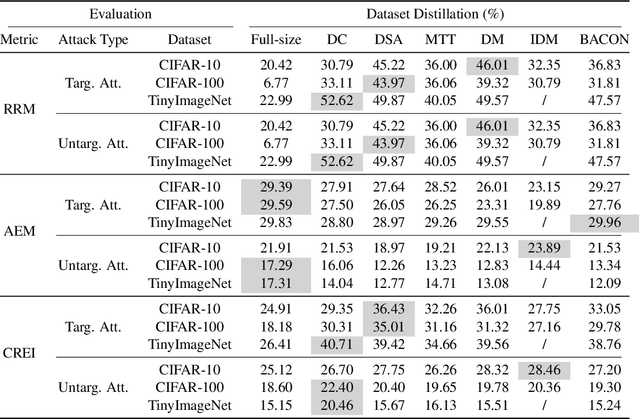
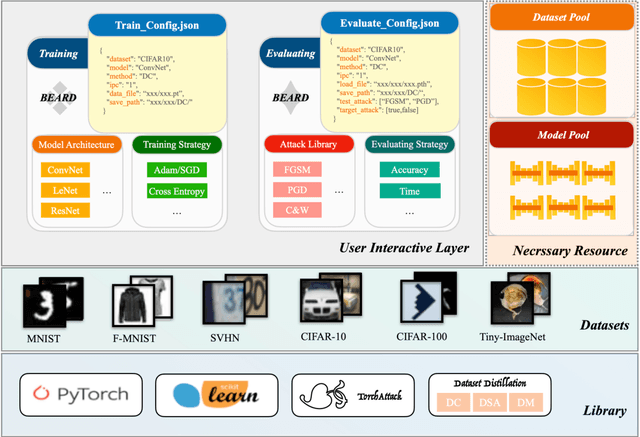
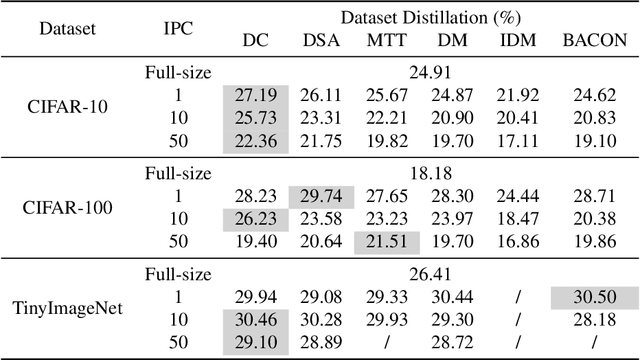
Abstract:Dataset Distillation (DD) is an emerging technique that compresses large-scale datasets into significantly smaller synthesized datasets while preserving high test performance and enabling the efficient training of large models. However, current research primarily focuses on enhancing evaluation accuracy under limited compression ratios, often overlooking critical security concerns such as adversarial robustness. A key challenge in evaluating this robustness lies in the complex interactions between distillation methods, model architectures, and adversarial attack strategies, which complicate standardized assessments. To address this, we introduce BEARD, an open and unified benchmark designed to systematically assess the adversarial robustness of DD methods, including DM, IDM, and BACON. BEARD encompasses a variety of adversarial attacks (e.g., FGSM, PGD, C&W) on distilled datasets like CIFAR-10/100 and TinyImageNet. Utilizing an adversarial game framework, it introduces three key metrics: Robustness Ratio (RR), Attack Efficiency Ratio (AE), and Comprehensive Robustness-Efficiency Index (CREI). Our analysis includes unified benchmarks, various Images Per Class (IPC) settings, and the effects of adversarial training. Results are available on the BEARD Leaderboard, along with a library providing model and dataset pools to support reproducible research. Access the code at BEARD.
BACON: Bayesian Optimal Condensation Framework for Dataset Distillation
Jun 03, 2024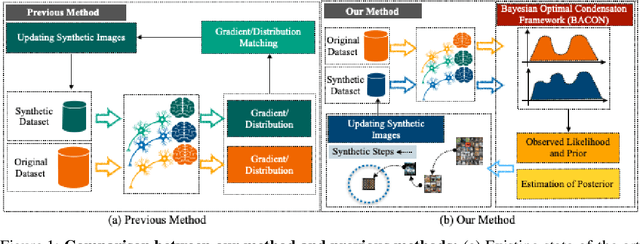
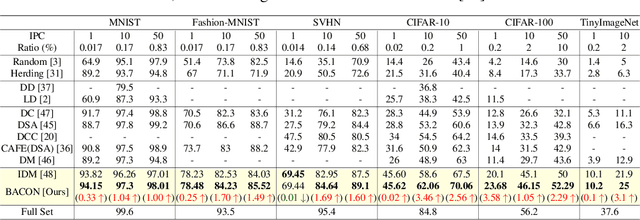
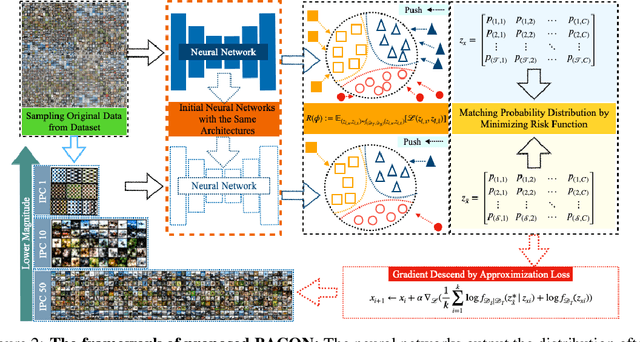
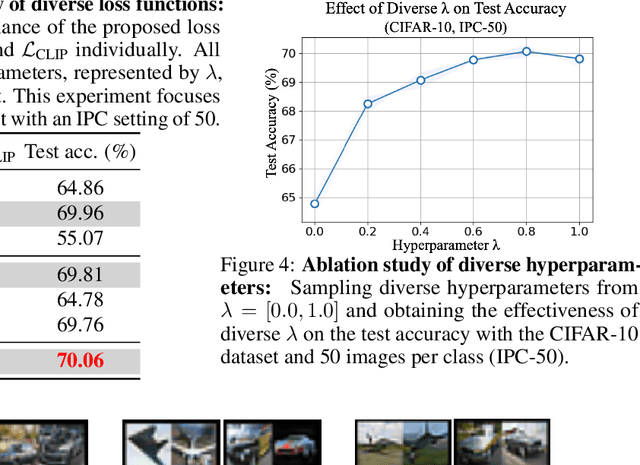
Abstract:Dataset Distillation (DD) aims to distill knowledge from extensive datasets into more compact ones while preserving performance on the test set, thereby reducing storage costs and training expenses. However, existing methods often suffer from computational intensity, particularly exhibiting suboptimal performance with large dataset sizes due to the lack of a robust theoretical framework for analyzing the DD problem. To address these challenges, we propose the BAyesian optimal CONdensation framework (BACON), which is the first work to introduce the Bayesian theoretical framework to the literature of DD. This framework provides theoretical support for enhancing the performance of DD. Furthermore, BACON formulates the DD problem as the minimization of the expected risk function in joint probability distributions using the Bayesian framework. Additionally, by analyzing the expected risk function for optimal condensation, we derive a numerically feasible lower bound based on specific assumptions, providing an approximate solution for BACON. We validate BACON across several datasets, demonstrating its superior performance compared to existing state-of-the-art methods. For instance, under the IPC-10 setting, BACON achieves a 3.46% accuracy gain over the IDM method on the CIFAR-10 dataset and a 3.10% gain on the TinyImageNet dataset. Our extensive experiments confirm the effectiveness of BACON and its seamless integration with existing methods, thereby enhancing their performance for the DD task. Code and distilled datasets are available at BACON.
MVPatch: More Vivid Patch for Adversarial Camouflaged Attacks on Object Detectors in the Physical World
Jan 12, 2024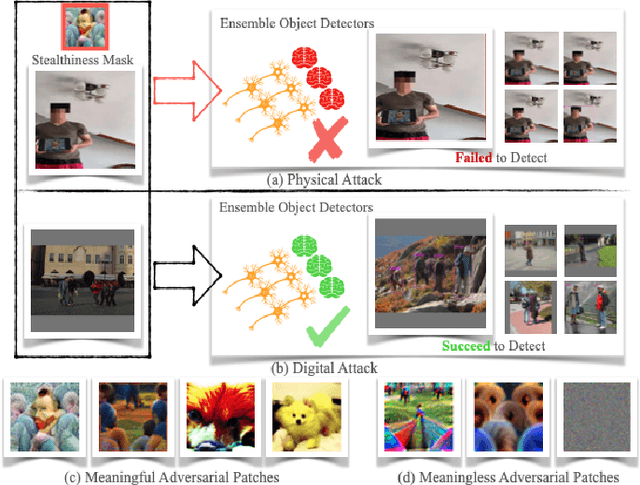
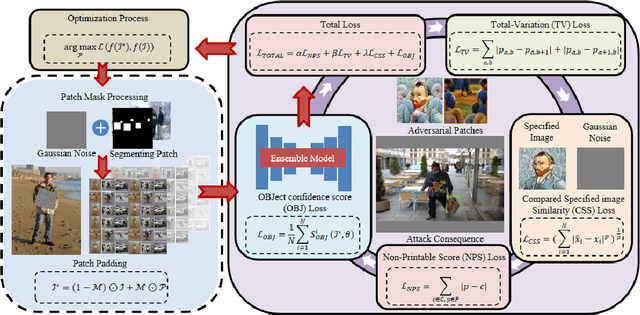


Abstract:Recent investigations demonstrate that adversarial patches can be utilized to manipulate the result of object detection models. However, the conspicuous patterns on these patches may draw more attention and raise suspicions among humans. Moreover, existing works have primarily focused on enhancing the efficacy of attacks in the physical domain, rather than seeking to optimize their stealth attributes and transferability potential. To address these issues, we introduce a dual-perception-based attack framework that generates an adversarial patch known as the More Vivid Patch (MVPatch). The framework consists of a model-perception degradation method and a human-perception improvement method. To derive the MVPatch, we formulate an iterative process that simultaneously constrains the efficacy of multiple object detectors and refines the visual correlation between the generated adversarial patch and a realistic image. Our method employs a model-perception-based approach that reduces the object confidence scores of several object detectors to boost the transferability of adversarial patches. Further, within the human-perception-based framework, we put forward a lightweight technique for visual similarity measurement that facilitates the development of inconspicuous and natural adversarial patches and eliminates the reliance on additional generative models. Additionally, we introduce the naturalness score and transferability score as metrics for an unbiased assessment of various adversarial patches' natural appearance and transferability capacity. Extensive experiments demonstrate that the proposed MVPatch algorithm achieves superior attack transferability compared to similar algorithms in both digital and physical domains while also exhibiting a more natural appearance. These findings emphasize the remarkable stealthiness and transferability of the proposed MVPatch attack algorithm.
 Add to Chrome
Add to Chrome Add to Firefox
Add to Firefox Add to Edge
Add to Edge